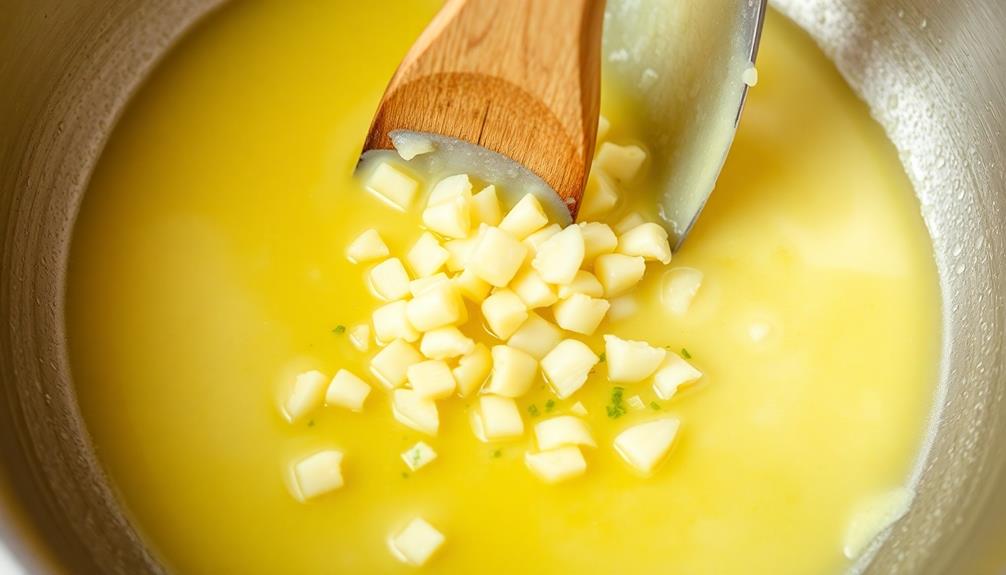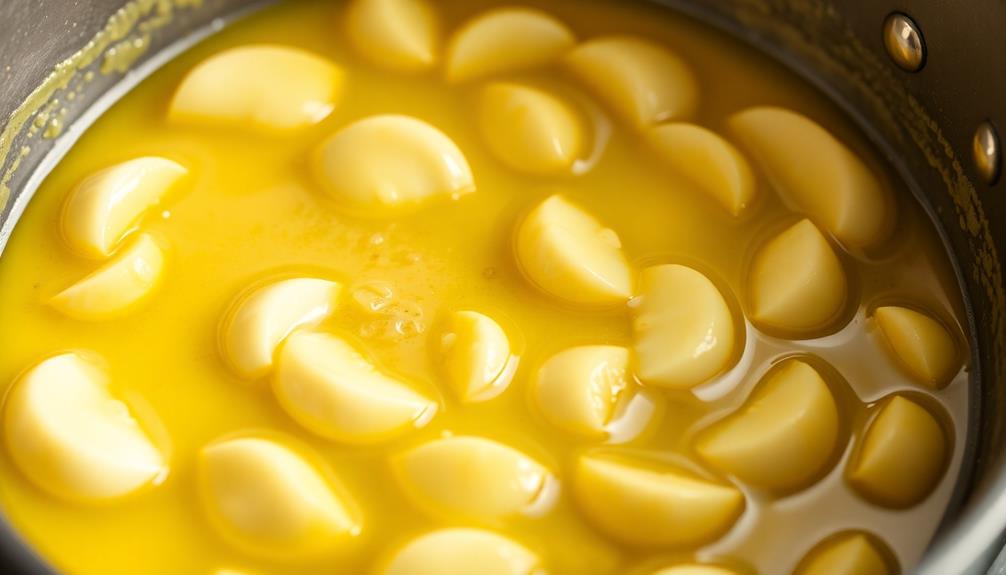Creating a creamy, aromatic garlic butter is a simple pleasure that's stood the test of time. This rich, versatile spread traces its roots back to ancient civilizations, where cooks first harnessed the bold flavors of garlic and butter. Over the centuries, the recipe has evolved, with the addition of fresh herbs, lemon, and spices taking it to new culinary heights. To make your own, just soften some butter, stir in minced garlic, parsley, salt, and pepper, then let the flavors meld. From there, the possibilities are endless – spread it on bread, toss it with pasta, or drizzle it over meat and veggies. Get ready to elevate your cooking with this timeless flavor powerhouse.
Key Takeaways
- Combine softened unsalted butter, minced garlic, finely chopped parsley, salt, and pepper for a creamy, flavorful garlic butter.
- Melt the butter in a saucepan, then simmer the garlic in the butter for 1-2 minutes to infuse the flavor.
- Use garlic butter to enhance the taste of freshly baked bread, grilled meats or seafood, mashed potatoes, pasta, and sautéed vegetables.
- Store the garlic butter in the refrigerator for up to two weeks or freeze it for longer-term use.
- Garlic butter offers health benefits as it contains antioxidants and healthy fats that promote skin and hair health.
History

The history of garlic butter can be traced back to ancient civilizations, where it was used as a flavorful condiment to enhance various dishes. Cultures from ancient Egypt, Greece, and Rome all recognized the culinary potential of combining creamy butter with the bold, pungent flavor of garlic.
As these civilizations grew and expanded, the use of garlic butter spread throughout the Mediterranean region and beyond.
During the Middle Ages, garlic butter became a staple in European cuisine, with recipes appearing in medieval cookbooks. Chefs and home cooks alike experimented with different techniques and flavor profiles, elevating the simple pairing of butter and garlic.
As trade routes expanded, the availability of high-quality butter and imported spices allowed for more complex and sophisticated garlic butter recipes to emerge.
Today, garlic butter remains a beloved and versatile ingredient, finding its way into a wide range of dishes, from grilled meats and seafood to freshly baked bread and pasta. Its enduring popularity speaks to the timeless appeal of this creamy, flavorful condiment.
Recipe

Creamy garlic butter is a versatile and flavorful condiment that can elevate a variety of dishes. Whether you're looking to add a burst of flavor to a piece of grilled fish, a steak, or even a simple slice of bread, this recipe is sure to impress.
The key to this recipe is the balance of rich, creamy butter and the pungent, aromatic notes of garlic. The addition of a few simple ingredients transforms ordinary butter into a gourmet spread that can be used in countless ways.
- Unsalted butter, softened
- Garlic, minced
- Parsley, finely chopped
- Salt and pepper to taste
To make the creamy garlic butter, simply combine the softened butter, minced garlic, and chopped parsley in a medium bowl.
Season with salt and pepper to taste, and mix well until all the ingredients are evenly distributed.
Transfer the mixture to a piece of parchment paper or plastic wrap, shape it into a log, and chill in the refrigerator until firm, about 30 minutes.
When ready to use, slice the chilled garlic butter into discs or dollop it onto hot dishes to let the flavors melt and infuse the food.
This versatile condiment can be stored in the refrigerator for up to two weeks, making it a convenient way to add a burst of flavor to any meal.
Cooking Steps

Melt the butter in a saucepan over medium heat.
Once melted, add the minced garlic and let it simmer, infusing the butter with its flavor.
Step 1. Melt Butter in Saucepan Over Medium Heat

Start by gathering a saucepan and your butter. You'll want to use a medium saucepan, as this will allow the butter to melt evenly. Place the saucepan on your stovetop and set the heat to medium.
As the saucepan heats up, add your butter. Depending on the recipe, you'll typically use around 4 tablespoons, or half a stick, of butter. Allow the butter to melt slowly, stirring occasionally with a spatula or wooden spoon.
The key is to not let the butter brown or burn, as that can impart a bitter flavor. Instead, you're looking for the butter to melt completely and become smooth and glossy.
Once the butter has fully melted, you're ready to move on to the next step in the recipe, which is adding the garlic. Keep a close eye on the melting butter to ensure it cooks gently and doesn't overcook.
With the butter melted, you're one step closer to creating your delicious creamy garlic butter.
Step 2. Add Minced Garlic to Melted Butter

Once the butter has fully melted, add the minced garlic to the saucepan. The aroma of the garlic will immediately fill the air, signaling the start of the flavor-building process.
Stir the garlic into the melted butter using a wooden spoon or whisk, ensuring it's evenly distributed.
Cook the garlic for 1-2 minutes, stirring frequently, until it becomes fragrant and starts to sizzle. Be careful not to let the garlic burn, as that can create a bitter, acrid taste. The goal is to gently cook the garlic, allowing its flavor to infuse into the butter.
Once the garlic is aromatic and slightly softened, remove the saucepan from the heat. This will prevent the garlic from burning and becoming overpowering. The residual heat in the pan will continue to cook the garlic, seamlessly incorporating its pungent, savory notes into the creamy butter.
Step 3. Simmer Garlic in Butter

Gently simmer the garlic in the melted butter for 1-2 minutes, stirring frequently. This step allows the garlic to infuse its rich, aromatic flavor into the butter, creating a delectable base for your garlic butter.
Be careful not to let the garlic brown or burn, as this can impart a bitter taste. The slow simmering process softens the garlic, making it more spreadable and intensifying its natural sweetness.
Once the garlic has simmered, remove the pan from the heat and let the mixture cool for a minute or two. This brief cooling period ensures the garlic doesn't continue cooking and become overpowered.
Then, transfer the garlic-infused butter to a small bowl or ramekin. Smooth the surface with a spoon or spatula, creating an evenly distributed layer of creamy, garlicky goodness. Garnish the top with a sprinkle of fresh parsley or a pinch of sea salt for added flavor and texture. For an extra touch, serve alongside a light, crispy baguette or some homemade mayonnaise from scratch to complement the rich, savory notes of the butter. Whether used as a dip or spread, this combination is sure to impress at any gathering. For those who enjoy a bit of customization, incorporating various herbs or spices into your garlic-infused butter can elevate the flavor to new heights. Pairing it with a homemade mayonnaise recipe made easy allows you to fully control the quality and taste of your condiments while impressing your guests with your culinary skills. This delightful combo turns even the simplest snacks into gourmet treats, perfect for any occasion or casual gathering.
Step 4. Season With Salt and Pepper

Season the garlic-infused butter with a pinch of salt and a few grinds of black pepper. The salt and pepper will enhance the natural savory flavors of the garlic, creating a well-balanced, seasoned compound butter.
Start with just a small amount of each – about 1/4 teaspoon of salt and 5-6 turns of the pepper mill. You can always add more seasoning later if needed, but it's harder to fix an over-salted or overly peppery butter.
Stir the salt and pepper into the butter until evenly distributed. Taste and adjust the seasoning as desired. The goal is to achieve a harmonious blend where no single flavor dominates, but they all work together in delicious harmony.
Once the seasoning is perfect, the garlic butter is ready to use. Spread it on freshly baked bread, melt it over grilled meats, or use it to sauté vegetables for an extra boost of garlicky goodness. The possibilities are endless!
Step 5. Transfer to Serving Bowl

Transfer the seasoned garlic butter to a small serving bowl or ramekin. This allows the compound butter to be easily spooned or spread onto fresh bread, crackers, or your favorite grilled meats and vegetables.
The creamy, rich texture and aromatic garlic flavor will elevate any dish.
To transfer the butter, use a rubber spatula to gently scoop the mixture from the mixing bowl and place it in the serving container. Smooth the top to create an even, attractive presentation.
If desired, you can lightly dust the surface with a bit of freshly ground black pepper or chopped parsley for added flavor and visual appeal.
Place the garlic butter near the main course or appetizers so guests can readily access it. Serve with a small butter knife or spreader for easy portioning.
Encourage guests to generously apply the compound butter to enhance the overall dining experience.
Final Thoughts

With the creamy garlic butter now prepared, you can start considering how best to use it. This versatile condiment can be a game-changer in your kitchen, elevating a wide range of dishes with its rich, savory flavor.
Consider using the garlic butter as a topping for freshly baked bread, steak, or seafood. It can also be incorporated into mashed potatoes, pasta, or vegetables for an instant flavor boost. For a quick and easy appetizer, try spreading it on crostini or crackers.
Beyond culinary applications, the garlic butter can even be used as a moisturizing skin treatment or hair mask. Its nourishing properties can leave your skin and hair feeling soft and rejuvenated.
Ultimately, the possibilities are endless when it comes to this creamy, flavorful butter. Experiment and discover new ways to incorporate it into your cooking and self-care routine. Enjoy the delicious results! From savory dishes to sweet treats, this versatile ingredient can elevate any recipe with its rich taste and texture. For an extra touch of creativity, try pairing it with a homemade buttermilk recipe tutorial to craft fluffy pancakes, tender biscuits, or even a soothing DIY face mask. Let your imagination guide you as you explore the countless ways to make this butter a staple in your kitchen and beyond.
Frequently Asked Questions
How Long Does the Garlic Butter Last in the Fridge?
The garlic butter should last about 1-2 weeks in the fridge when stored properly. Keep it in an airtight container and it'll stay fresh and flavorful for several days. Just be sure to check for any signs of spoilage before using.
Can I Use Margarine Instead of Butter?
You can use margarine instead of butter, but the flavor and texture won't be the same. Butter has a richer, creamier taste that margarine can't replicate. Keep in mind that the shelf life may also be different.
Does the Garlic Butter Freeze Well?
Yes, the garlic butter freezes exceptionally well! You can make a batch, freeze it in small portions, and easily thaw it whenever you need a delicious, flavorful butter for cooking or spreading. It's a great way to preserve the freshness.
How Do I Prevent the Garlic From Burning?
To prevent the garlic from burning, sauté it over low heat and avoid overcrowding the pan. You can also add the garlic later in the cooking process to minimize its exposure to high heat.
Can I Substitute Dried Herbs for Fresh Ones?
You can certainly substitute dried herbs for fresh ones, but you'll want to use about half the amount as dried herbs are more potent. The flavors may not be as vibrant, but it's a suitable swap.









